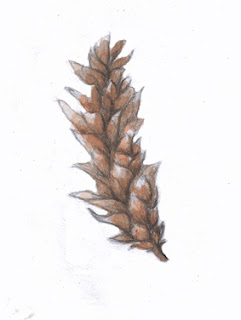 |
| Female Pine Cone Drawing |
I
visited the Hamptons this past Thanksgiving weekend and gathered some pine
cones much as I have been doing since I was very little. I decided to draw one,
and I always read about whatever I am drawing so that I can know it
better. It helps my drawing and my writing. I read that
pine cones have genders, or is it sexes? I knew that pine cones were
the reproductive parts of pine trees (genus Pinus) from my Plant Morphology class at the NYBG, (a class I highly recommend) but I
didn’t think about them as male and female. I wondered whether
they would be easy to tell apart. I wondered which ones I collect and
draw. It turns out the ones I’ve been gathering are the females—ones
that have completed their reproductive cycle. Young female pine
cones are soft, sticky, green, and large; they grow for about two seasons while
their seeds develop. After they are fertilized, they continue to
grow while the seeds mature and gradually they turn brown, woody, and spiky to
protect the seed. Then they open up and let the wind distribute the
seeds; eventually the female pine cones die and fall off the tree for animals
including humans of all ages to gather.
In the pine cone world it seems it is easy to tell the males
from the females by size: the males are smaller, softer, tighter, and more
closed. Most pines are monoecious, having the male and female cones
growing on the same tree. The male pine cones or strobili usually grow toward
the bottom of the tree and the females grow toward the upper
half. Pines are gymnosperms, a word that means “naked seed,” plants
that evolved cones to carry their reproductive structures—ovules for the
females that develop on the scales of the cones rather than in ovaries. The
pollen comes from the male cone, and the wind blows it into the female
cone. Many species of birds and squirrels feed on pine cones, and
just as I found out with acorns, squirrels and birds are not the only ones that
eat pine cones. Humans eat parts of the pine cones—the pine nuts--but we
usually toast them before we eat them. Then there is the
artistic joy of pine cones—they are great to marvel at for their structure and
then to draw.

No comments:
Post a Comment